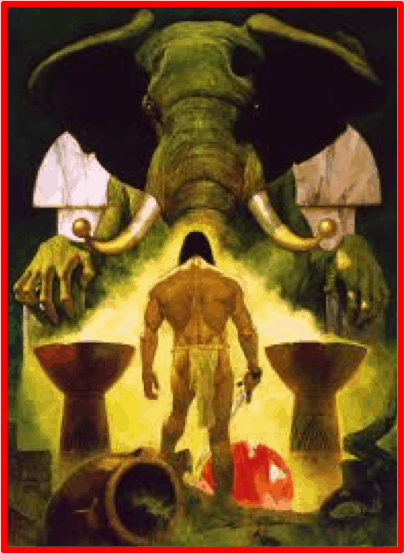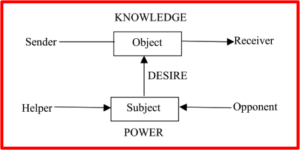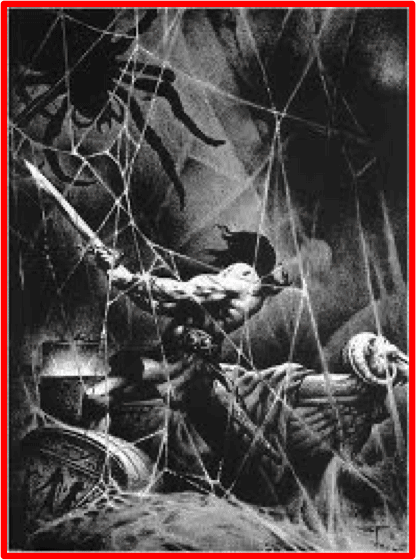This is the fourth in a series of story structure blog posts analysing Robert E Howard’s celebrated story, ‘The Tower of the Elephant’, which is summarised here. The previous posts deal with the following models or processes:
The Actantial Model
During the 1960s, structuralist semiotician Algirdas Greimas, using Vladimir Propp’s theories, developed the actantial model, which can be used to examine and describe the different roles, functions and actions in narratives. The model shows the key players in a story:
- Sender: Who or what wants the object and requires a subject to get it?
- Receiver: Who or what gets the object in the end?
- Subject: Who is the ‘main character’, the seeker of the object?
- Object: What is the project, goal or thing that the sender wants the subject to obtain?
- Helper: Who or what helps the subject to get the object?
- Opponent: Who or what tries to prevent the subject from getting the object?
These six actants are arranged in three oppositions that display their connections and forces.
- Transmission (Knowledge) axis: The start of the story is the moment the sender initiates the quest for the hero. The end of the story occurs when the subject hands over the object to the sender who then hands it to the receiver (who is sometimes the same as the subject).
- Desire axis: Displays the subject (main character) and the object (goal of the main character).
- Power axis: Shows the helper and the opponent, who are respectively trying to help and to prevent the subject from succeeding.
The following is an analysis of the roles in a typical folk tale: the rescue of a princess.
The axis of transmission (knowledge)
Sender: The king
Receiver: The king and his kingdom/people, or the hero, who receives the hand of the princess in marriage
The axis of desire
Subject: The prince or commoner sent on the quest
Object: The rescue of the princess
The axis of power
Helper: The wise woman or man or talking animal that provides advice or a talisman or a weapon
Opponent: The dragon
Below, I have applied the actants to ‘The Tower of the Elephant’:
Sender
This is obviously the unnamed Kothian slave trader, who boasts he would steal the treasure, though it soon transpires he hasn’t the courage to do so. His pronouncement in the tavern about ‘the secret of the Elephant’s Tower’ is the trigger for Conan to go on his quest. (Such a moment is what some story practitioners would call the ‘Inciting Incident’.)
There is also a suggestion that Yag-kosha has set up the conditions for Conan’s arrival at the tower (‘the unseen play of vast Outer forces’). Although this is not stated outright, Yag-kosha does say to Conan ‘You are the hand of Fate’. This is after Conan has told him about the recent deaths he has been involved with and Yag-kosha has announced, ‘A slaying in the tavern and a slaying on the road—I know; I feel. And the third will make the magic of which not even Yara dreams—oh, magic of deliverance, green gods of Yag!’ (my italics). And in the last paragraph, Conan himself wanders about the whole adventure: ‘Was he bewitched and enchanted?’
Receiver
Again, this is obvious: Conan, who is looking to keep the treasure for himself, or at least for as long as it takes for him to find a buyer, so he can live off the proceeds of his daring robbery for a while. The irony of the story is that he is not the ultimate receiver. Through Conan’s actions, the strange ‘transcosmic being’ Yag-kosha ends its life on Earth on its terms and is able to take revenge on Yara, its captor, which is the object of its own story.
Subject
Conan again. The slave trader inadvertently sends him on the quest to retrieve (steal) the treasure. If we look at the ‘desire’ element of the model, obviously the Kothian slave trader does not have sufficient desire to go after the jewel himself. On the other hand, Conan has the self-belief that he has ‘the will and might’ and a desire ‘coupled with courage’ to go through all obstacles. It is this self-belief that so threatens the Kothian’s self-esteem that the trader challenges Conan and ends up being killed.
Object
The treasure, the gem called the Heart of the Elephant. Yet, the mission to steal a thing becomes a mission to help an imprisoned near-immortal being (‘our lives are as the lives of planets and constellations’). In essence, at this point in the story Conan becomes a new subject: the person who will release the god, which is the new object of the story. As suggested above, it is also possible that the true object of the quest in the first place was the release of Yag-kosha, with that entity having been the true sender.
Helper
Taurus of Nemedia, the prince of thieves, helps Conan in the warrior’s heist. However, at the start of their relationship, Taurus likely sees Conan as his helper. For example, it is the warrior who manages to kill the lion unaffected by Taurus’s poison mist. It is also possible Taurus intended Conan to be cannon fodder of some sort during the thief’s likely encounters with Yara’s guards and with the high priest himself.
I would contend that Taurus also sees Conan as a rival, for why else does he send the youth on a scouting mission around the tower while he himself slips into ‘the glittering chamber’ atop the tower? Even Conan suspects this: ‘a faint suspicion of his companion touched his wary soul’, then dismisses the thought. Of course, by taking this step, Taurus condemned himself to death at the hands of the giant black spider. If he had seen Conan as an equal partner, they both would have entered the room together and two sets of eyes may have spotted the danger before it was too late. Taurus’s greed was his undoing, though his death gave enough reason for Conan to be cautious when he entered that room. In this way, Taurus helped Conan survive the encounter with the spider. Ultimately, though, Conan becomes the helper to Yag-kosha’s escape from captivity and its revenge on Yara. This shows that in the actantial model, an element in a story can have multiple roles or actants.
Opponent
There are many possible and actual obstacles. The walls. The sentries. The lions. The tower itself. (Conan was so reliant on his ‘will and might’ to win entry that he didn’t even think of bringing a grappling hook and rope. Luckily, his helper, Taurus, came well equipped.). The ‘gigantic black spider’. The tower guards. Yara himself. The otherworldly Yag-kosha (also called Yogah of Yag) could be seen, at one point, as an opponent also, for his existence and plight stood in the way of Conan gaining the physical treasure of the Elephant’s Heart. Luckily for Yogah of Yag, Conan felt ‘great pity’ for it and ‘shrank with shame, as if the guilt of a whole race were laid upon him’ for what had been done to the creature. He put aside the desire for personal gain and freed Yag-kosha. In doing so, Conan gained a psychological treasure, the awareness of his capacity for empathy and sympathy. This is an unintended object of the story, with Conan the receiver.
An aside: I have often wondered about the two names of the strange creature Conan meets. Is it possible that Yogah of Yag is its true name, whereas Yag-kosha is the name it gives itself while imprisoned by Yara, a name that conveys its state of anguish and torment? Since Yag is the name of its home planet, then Yag-kosha may mean something like ‘captive exile of Yag’, in the sense of its not being able to return. Once freed, Yag-kosha becomes Yogah of Yag and is able to use the full resources of its own magical powers to enact revenge on Yara and then return in some way to Yag. The fact that the ‘transcosmic being’ told Conan its true name, which we know from fairy tales is not something done lightly, but did not tell Yara, shows that Yogah trusted the warrior and is another sign that it guided Conan to take on the adventure.
I hope the above application of this literary model has given you further insights into Howard’s story and show you how it can be applied to others that you read. For the writers amongst you, whether literary or genre—I’ll leave the debate about this artificial divide to another post—can see how the model and the associated questions provided above can provide a way of understanding and constructing the forces in a story or in one of the subsets of a story (scene, sequence, act, sub-plot, etc.).
If you have any comments about the post, do let me know. Thanks.
Be well and inspired!
Cofion gorau (Best wishes)
Earl
______________________________________________________




